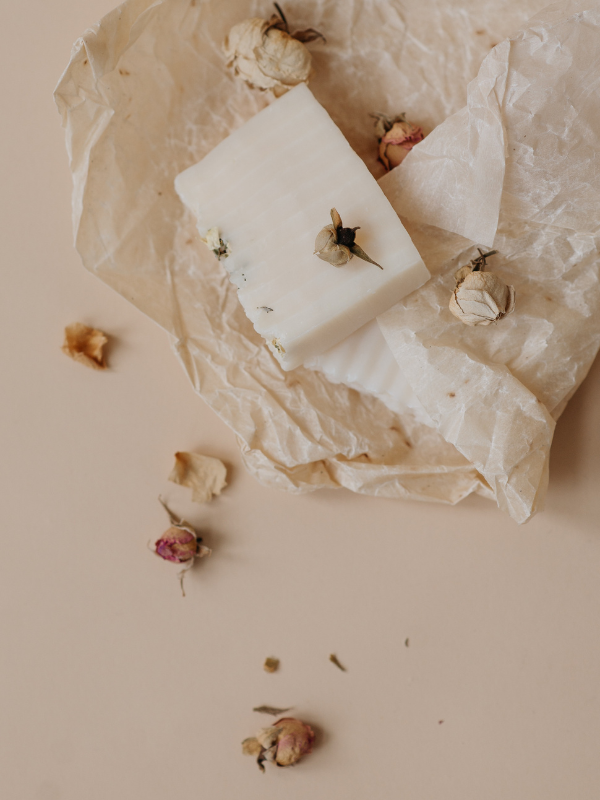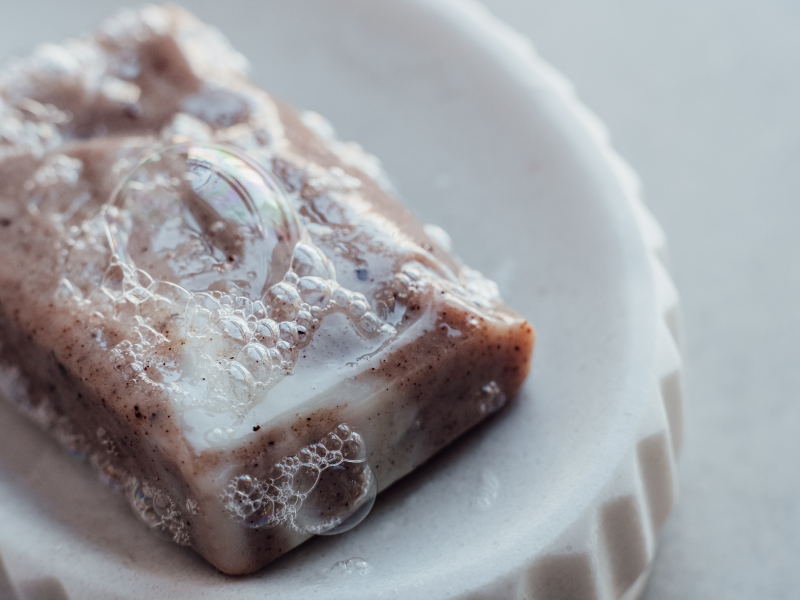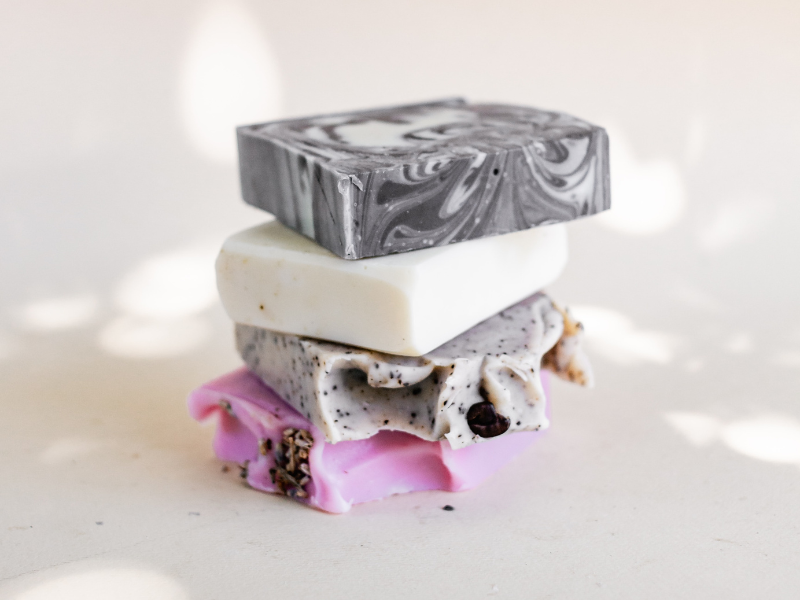Many of the products you buy often can easily be made in the comfort of your own home, from DIY furniture to homemade cosmetics like hair masks or body scrub. Homemade soap might pique your curiosity. Making mild soap can be both fun and rewarding. In addition, you can choose ingredients and fragrances based on your preferences.
By definition, soap is oil mixed with lye. In the production of soap, the alkali is sodium hydroxide. Liquid soap requires potassium hydroxide. Soap is created by combining and then heating oil and lye. This chemical reaction is called saponification. Without lye, saponification is not possible, so lye is necessary to create soap.
Key ingredients for making soap
To make soap at home, you will need two elements for saponification: fatty and alkaline material. Any type of fat will do – olive oil, coconut oil – but different fats give soap different properties.
Olive oil is good for moisturizing, but it does not create a good lather. Coconut oil creates a nice lather, but leaves the skin feeling dry.
Alkaline material is alkali. Sodium hydroxide is a type of lye used in soap, while potassium hydroxide is used for liquid soaps. A combination of both can be used to make a gel-like soap.
Lye is necessary for soap making, but it can be dangerous to work with because it is extremely corrosive. It can burn skin and make holes in fabric. Therefore handling lye requires a well-ventilated area and safety equipment - gloves and eye protection.
Through the process of saponification, which can last from several days to weeks, the lye is removed from the recipe. The chemical reaction that takes place rearranges the molecules in the lye and turns the grease and lye into soap. Therefore, there is no remaining lye in the finished soap.
If you are worried about handling lye, you can buy a soap base. This is basic soap that has already undergone the saponification process. You can melt it and add fragrances or scrubs of your choice, a process known as melt and pour soap making.

Methods of making soap
There are three main methods for making soap at home:
Melt and pour
This includes shopping soap bases, dissolving and adding the ingredients you want – from fragrances to essential oils – and then pouring the soap into the mold. Saponification has already taken place, so you don't have to worry about handling the lye, and the soap can be used immediately after it cools down. This is a good option if you want to involve children in your soap making process.
Cold process
This includes making soap from scratch using lye and grease. Heating is not included, but willtake 4 to 6 weeks for soap to harden, so that the saponification is complete and all the lye disappears.
Hot procedure
This also includes making soap from scratch. Heat is used to accelerate saponification, for example from a cooking pot, so the soap can be ready in just a week.
Basic accessories and tools for making soap
Basic supplies for making soap:
plastic or stainless steel container for measuring lye
plastic or stainless steel container for mixing lye and water
digital kitchen scale
silicone or wooden spatulas/cookers
stick blender (with stainless steel shaft)
thermometer
molds – old wooden containers, shoe box, silicone molds, individual molds. It is important to cover them with baking paper (if they are not silicone) and you can use that paper again.
Safety equipment for making soap
You will also need safety equipment, such as:
goggles
rubber or latex gloves
oven glove
long sleeve shirt
apron
well-ventilated work area
If you use the equipment, there is no risk of injury.
Tips for choosing soap ingredients
The basic ingredients of the soap are:
Vegetable oil
100 percent pure lye
distilled water
essential fragrance oils or skin-safe oils (optional)
natural dyes (optional)

Oils
The best oil depends on your preferences. Depending on your oil, the hardness and lather of the finished soap will vary. Examples of oils used in soap making include:
olive oil
coconut oil
avocado oil
almond oil
jojoba oil
hemp oil
cocoa butter
mango butter
shea butter
Water
Water is an essential ingredient. It is used to make a lye solution that is combined with oil. The water helps the oil and lye to complete the saponification process. By the time the soap hardens, most of the water will have evaporated. It is recommended to use distilled water. However, other liquids can be used, such as:
tea
kava
beer
coconut milk
These options can be difficult to work with if you're a beginner, so you might want to stick to water for your first try.
Fragrances
Soap is not required fragrance to keep your skin clean. But if you want to add a pleasant fragrance, you can use essential oils or fragrance oils. Essential oils are mostly plant-based, and you can combine them to create custom aromas. Fragrance oils are synthetic. When choosing fragrance oils, look for skin-safe options.
Creating your own soap recipe
Following a recipe is helpful when you're a beginner, but what if you feel ready to start experimenting with your own blends of scents and ingredients?
Before you start making your own ideas, it is important to meet yourself with the basics of soap making.
Creative experimentation can absolutely add more fun to the process. But getting some basic experience first can help you understand how to handle ingredients safely and prevent creative creations from becoming safe risks.
Tips to keep in mind:
Using the recipes will help you understand the proper ratios of lye to oil which are necessary to avoid the formation of soap that irritates the skin. For example, crumbly soap is an indication that it contains too much lye.
Different oils can lead to a different finished product. By trying different recipes that use different oils, you can get a feel for the type of soap each oil produces. Then, once you're comfortable, you can start experimenting.
By deciding on the purpose of the soap, you can determine the target percentage of superfat in advance (superfatting) or the ratio of oil and alkali. Superfatting refers to the amount of oil left in your finished soap ie it is the excess oil in the soap that has not turned into soap. Use of lye calculator can help you (safely) match the proportions of the ingredients to the desired result.
The input data for the online calculator is weight of individual oil and superfatting level. The calculator will calculate how much water and lye (NaOH) should be added. Superfatting level is usually used in from 0.5% to 10% (never 0%). For example, a superfatting of 5% means that there is 5% oil left in the final soap that has not turned into soap.
All the lye (NaOH and water) should react with the oil so that there is no hidden NaOH in the soap that could harm the skin. You want the soap to be mild and nourishing to the skin. A superfatting level of more than 10% will cause a crumbly soap and it will last less because there will be more oil left in it that can go rancid.
When making soap, it is recommended to choose at least three oils, depending on their properties – the amount of soap, the level of skin care and the hardness of the soap. Each oil has individual properties. Also, for each oil used, the amount of water and caustic soda is calculated, depending on the saponification factor. For example, if we want a soap that lathers well, is firm and takes good care, we will use coconut, olive and almond oil. Coconut oil creates good lather and soap firmness, while olive oil has nourishing properties but also creates soap firmness. For additional care, you can add, for example, almond oil. The possibilities are endless. Playing around with fragrances, oil types, and water alternatives in existing soap recipes can help you come up with your own recipe. To basic oils various essential oils can be added (usually around 2.5%) to achieve fragrance and healing properties. You can also add dry herbs to the soap.

Making soap using the cold process
Step 1:
Prepare soap molds. Use old wooden containers, shoe boxes, silicone molds, it is safer not to use metal. Cover the mold with greaseproof paper.
Step 2:
All the oils you use should be in a liquid state.Place the jars of oil in a bowl of hot water to dissolve the oils. Place a large container for mixing soap (plastic or stainless steel) on the scale. Pour in the whole olive oil and weigh the mass of oil. Then add liquid coconut oil and weigh the mass of coconut oil. Let the proportion of coconut oil be about 20% of the total mass of oil.
Step 3:
In the calculator, select the settings: solid, grams and superfatting level 5%. Then add the mass of olive oil and coconut oil. The calculator will calculate how much lye and how many grams of water are needed for your soap.
Step 4:
In plastic containers weigh the water and lye. This part of the procedure is best done outdoors or in a well-ventilated room!
Carefully and slowly add the lye to the distilled water (never water to lye!). Stir the mixture with a wooden object. The solution will start to evaporate and heat up. Leave to cool, stirring occasionally. Make sure the room is well ventilated if you are not outside because harmful gases will also develop! The solution has now reacted and is hot almost to boiling point. Allow the solution to cool to about 50°C.
Use a thermometer to check that the oils and the lye solution are at a similar temperature. If they are, we move on to the next step.
When both the oil and the lye are at a temperature of around 50°C slowly pour the lye into the container with the oils with gentle mixing (No oils in lye!)
Step 5:
Mix the mass with a stick mixer and in 10-15 minutes you will get a thick "pudding". At this point you can add essential oils and desired additives, for example dried flowers, mineral or natural colors, green clay, seeds. Essential oils should be in equal proportions, about 2.5% of the total mass of oil. Mix the essential oils well with the obtained mass.
Now you can pour into the soap mold. Cover the mold with soap with two or three towels to preserve the heat in order to maintain the elevated temperature necessary for successful saponification. Leave to harden.
Step 6:
After 24 hours, the soap can be removed from the mold and cut into the desired shapes. Then it should be left in a well-ventilated place, but indoors, to ripen for another four weeks (a month). It is important that all the water evaporates and that the soap becomes hard.
Soaps should be stored in a dry place so that they can last for many months or even years.
Making of caustic soda (NaOH) soap
Also known as soap "melt and pour", this method allows you to create soap without the danger of working with caustic lye. You need a soap base which you will dissolve and only a few other ingredients.
Ingredients needed to make soap without lye:
- 250 ml of natural soap - Look for soap that does not contain chemicals and fragrances, carefully look at the label. The simpler, the better.
- 220 ml distilled water – In addition to water, possible liquids include coffee, green tea, infused herbs, coconut milk, and floral hydrosol.
- 11 ml of vegetable oil - olive oil, almond oil or whatever you want
- 5-6 drops of your favorite 100% essential oils
- Herbs or herbal powder – Dried or even fresh lavender, dried or fresh rose petals. Plant powder can be used as a natural colorant. Turmeric, for example, turns soap into a lovely orange color while giving it nutritious qualities. Spirulina powder makes a nice green color. Ground oatmeal provides a nice exfoliating quality. You can use cinnamon, cocoa, saffron, etc.
Accessories you need:
- Soap cutter
- Molds - use the molds listed above in the text
- 1 cooking vessel
- 1 wooden cooking spoon
Procedure:
Step 1:
Grate the soap base into the cooking pot. Then melt it stirring constantly with a wooden spoon. The soap will begin to thicken.
Step 2:
Add liquid a little at a time until you reach a good density level. Stir all the time.
Step 3:
Add selected vegetable oil and stir.
Step 4:
Add essential oils and any coloring powder if you chose it, then mix well.
Step 5:
Pour the mixture into the moulds when it is very thick. Leave the soap to stand for 6 weeks.
Making soap with baking soda
bicarbonate of soda in soap production
The fine white powder of sodium bicarbonate (baking soda) is very effective in skin care and beauty. And as such, it is widely used in the production of organic homemade soaps and washing products. Including baking soda in the mix helps with the saponification process resulting in a hard tile to work with. This also helps to affect the lather, so you don't end up with a soft mixture that doesn't wash very well.

When it comes to making soap with baking soda instead of lye, there are safety procedures you want to follow. But the good part is that you can avoid most of the harsh effects on the skin, unlike using lye.
Direct contact of baking soda with the skin can be very irritating, especially for people with sensitive skin. That is why it is recommended to use diluted baking soda (which includes baking soda in soap) on the skin.
Why consider baking soda in your soap?
There are many ways baking soda can be effective in soap making, and if you're wondering how, below are reasons to include it in your laundry products.
Treat a yeast infection
Whether you use baking soda in baths or mix it into soap ingredients, it will really benefit your skin. Do you want to get rid of all the swelling and itching due to a yeast infection? You can trust that baking soda will help kill the candida cells responsible for the spread.
Skin infections
In addition to yeast infections, baking soda will help you with many other skin problems. You can add it to bath water or to make soap to help you deal with psoriasis, eczema, fungal infections and nail infections. It will also help treat diaper rash in babies.
Necessary ingredients for making soap:
- 455 g of castile soap (it is a natural product based on olive oil - 100% natural, organic and vegan soap)
- 455 g of baking soda
- 95 ml of distilled water,
- 5 grams of oat extract,
- 5 grams of oatmeal,
- a few drops of natural essential oil as desired
Procedure:
Step 1:
Grate the castile soap to melt it more easily.
Step 2:
Melt the soap in steam. So, put the soap in a bowl that you place on top of another bowl where the water is gently boiling.
Step 2:
In a bowl mix baking soda with distilled water.
Step 3:
Add a mixture of baking soda and water to the soap and stir the mixture several times until it melts gently.
Step 4:
Add oat extract and essential oil into the mixture and mix everything.
Stir constantly. If necessary, add a little water.
When you get a mixture similar to paste or puree, put it in a mold. Sprinkle with oatmeal.
After 2-3 days, remove the soap from the mold and cut as desired.
Sources:
www.healthline.com/health/how-to-make-soap#creating-a-recipe
wholenewmom.com/how-to-make-soap-how-to-make-homemade-soap/
greenlivingzone.com/

